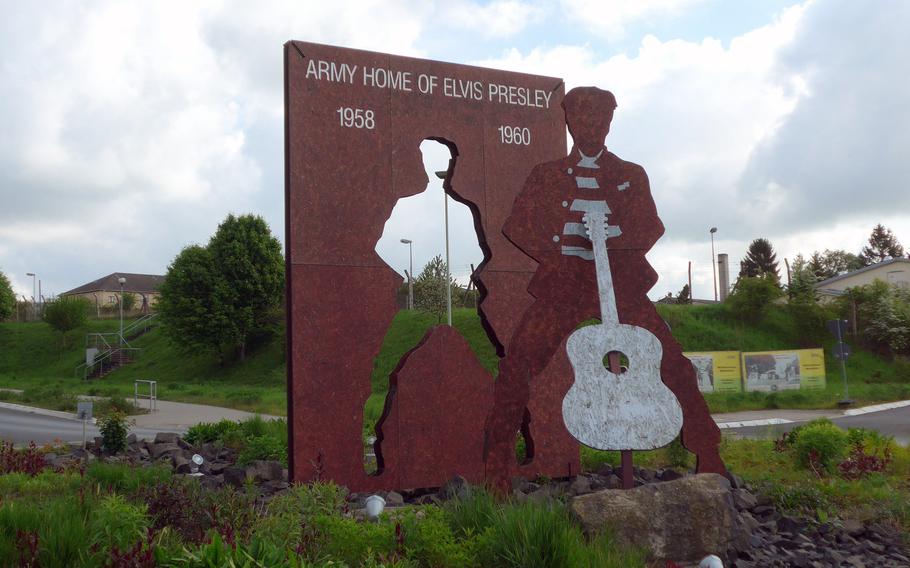
This statue of Elvis Presley stand in the middle of a traffic circle across from where the main gate to Ray Barracks in Friedberg, Germany, was during his time in the service there from 1958 to 1960. (Michael Abrams/Stars and Stripes)
Many people have called Friedberg, Germany, home. The Romans once lived here; the Germans still do, of course; and even Americans called it home, including one Elvis Aaron Presley.
Presley didn’t actually live here — he rented a house in nearby Bad Nauheim — but he was stationed at the U.S. Army’s Ray Barracks when he served with the 3rd Armored Division from 1958 to 1960.
The Army left Friedberg in 2007, but a statue of “The King” stands on a traffic circle across from where the main gate to the base was during Presley’s time.
The city has also honored Presley, naming a downtown square after him. It abuts Kaiserstrasse, Friedberg’s store-lined main street.
One of the town’s main attractions stands at the top of Kaiserstrasse, the Burg.
Friedberg Castle is one of the biggest in Germany, but don’t expect a medieval fortress. True, it is surrounded by fortifications, but once you walk through its massive southern gate, you’ll be surprised by the varied architecture. There are half-timbered houses, a Renaissance palace, an 18th-century classicist church and a modern school within its walls, but also the medieval Adolfsturm.
The 190-foot-tall tower is also the oldest building on castle hill, built around 1347. You can climb it on weekends for a view of the town and its surroundings.
Most of the city’s other tourist sites are in the narrow lanes of the old town.
If you don’t mind climbing down steep, uneven medieval steps, don’t miss the Judenbad, or Jews’ Bath, on Judengasse. The ritual Jewish bath, known as a mikweh, dates to the 13th century and is one of the few preserved medieval baths in Europe. A staircase leads down to it, about 80 feet below the surface.
Nearby is Synagogenplatz. Here once stood the Jewish synagogue, destroyed by the Nazis in the 1930s. It probably dated back to the 13th century, the first time there was a Jewish community in the city.
Walk back up Judengasse and Engelsgasse and you come to the Stadtkirche, or City Church. Built between the late 13th century and the early 15th century, it was once a Catholic church, but Protestant since the Reformation.
It has colorful stained-glass windows, mostly of scenes from the New Testament. Check out the beautiful Christmas Window.
Across the street is the Wetterau Museum. It features, among other things, historical artifacts from the area and a display about agriculture in the Wetterau, the hilly, pastoral region of central Germany where Friedberg is located.
And of course, it has a section dedicated to the King of Rock and Roll.
Friedberg, Germany
DIRECTIONS
Friedberg is about 36 miles from Wiesbaden taking autobahns A66 and A5 or about 90 miles from Kaiserslautern on A63, A60 and A5. When you exit, follow B455 to town. If you are using a navigation device, be sure you are heading for Friedberg in Hessen, not the one in Bavaria.
TIMES
• The Wetterau Museum is open 9 a.m. to noon and 2 p.m. to 5 p.m. Tuesdays-Fridays. The museum opens an hour later Saturdays; 10 a.m. to 5 p.m. Sundays and German holidays.
• The mikweh (ritual Jewish bath) has the same hours during the week, but is open from open 9 a.m. to noon and 2 p.m. to 5 p.m. Saturdays and Sundays.
• The Stadtkirche is open from 2 p.m. to 4 p.m. Tuesdays-Fridays; 11 a.m. to 5 p.m. Saturdays and Sundays.
• The Adolfsturm (castle tower) is open 2 p.m. to 6 p.m. Saturdays, Sundays and German holidays from April to October.
COSTS
• Admission to the museum is 4 euros (about $4.50) for adults and 2 euros for children.
• The mikweh charges 2 euros for adults and 1 euro for kids. • Adults pay 2 euros to climb the Adolfsturm, children 6 years and older pay 1 euro, under 6 go free.
• Parking costs 2 euros for two hours at meters in town. Look for the City Parkhaus if you plan a longer stay. Prices there are 70 euro cents for the first hour and 50 cents for every hour after that.
FOOD
There are plenty of places to eat in all price classes in the old town and along Kaiserstrasse. Fast-food restaurants are on the road leading to Friedberg coming from the autobahn.
INFORMATION
The German language-only website iswww.friedberg-hessen.de.